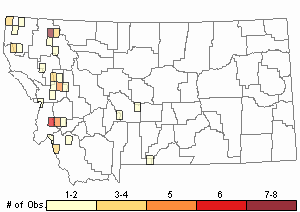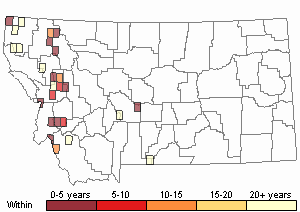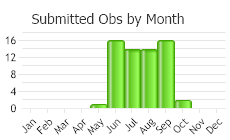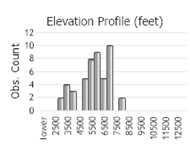View in other NatureServe Network Field Guides
NatureServe
Montana
Utah
Wyoming
Idaho
Wisconsin
British Columbia
South Carolina
Yukon
California
New York
Orange Peatmoss - Sphagnum subsecundum
General Description
Plants: Growing in short, open cushions (Crum and Anderson et al. 1981), slim, green, ochre or more golden, the small capitulum with curving branches (Crum and Anderson et al. 1981) and lacking a terminal bud (FNA 2007).
Stems and Stem Leaves: Stems pale to deep brown. Stem leaves tongue-shaped and somewhat deltoid, up to 0.8 mm in length (FNA 2007), not as long as the branch leaves; apex rounded, cupped and hood-shaped (Crum and Anderson et al. 1981), smooth or faintly toothed (FNA 2007).
Branches and Branch Leaves: Branches typically short and rounded, the pendent branches comparable to the spreading ones (FNA 2007); 4-7 branches per cluster, 2-4 of those pendent (Smith 1980). Branch leaves widely egg-shaped, tending to point toward one side (FNA 2007), inrolled, strongly cupped, 1-2 mm in length (Crum and Anderson et al. 1981).
Stem and Stem Leaf Cells: Outermost cortex consisting of 1 tier of swollen, fine-walled cells. Hyaline cells of the stem leaves occasionally partitioned, lacking both fibrils and pores apart from close to the apex (FNA 2007).
Branch and Branch Leaf Cells: Branch stems enclosed by 1 layer of swollen, fine-walled retort cells that lack fibrils and are typically intermixed with rectangular cells that lack pores. Hyaline cells of the branch leaves with copious tiny pores (18-40 to a cell) displayed on the outer (dorsal) leaf surface, arranged in uninterrupted rows along the cell margins juxtaposed with the green cells, the ventral surface typically lacking pores; green cells in X-section exposed similarly or slightly more at the convex leaf surface, the end walls at both surfaces of normal thickness (FNA 2007).
Diagnostic Characteristics
S. subsecundum is the most prevalent species in the section Subsecunda, with stem leaves tiny relative to comparable species (FNA 2007).
Range Comments
North American Range
Canada: Present in most of the provinces and territories; USA: in the northeastern states, extending to IL, WI, and MN, and in the west from WA to CA, ID, and MT to CO (FNA 2007). Known in Montana from Beaverhead, Deer Lodge, Flathead Lake, Lincoln, Missoula, Meagher, and Park Counties (Elliott 2016).
Observations in Montana Natural Heritage Program Database
Number of Observations: 67
(Click on the following maps and charts to see full sized version)
Map Help and Descriptions
Relative Density

Recency



 (Observations spanning multiple months or years are excluded from time charts)
(Observations spanning multiple months or years are excluded from time charts)
Habitat
Minerotrophic, on the margins of exposed, poor fens, occasionally in exposed medium fens (FNA 2007), wet areas with a lot of sedges, on the margins of bog mats where water verges on alkaline, beside streams and drainage furrows (Crum and Anderson et al. 1981).
Reproductive Characteristics
Dioicous. Fruits scarce. Capsule protruding beyond the perichaetial leaves, arrayed with a small number of pseudostomata (FNA 2007).
Stewardship Responsibility
References
- Literature Cited AboveLegend:
 View Online Publication
View Online Publication Crum, H.A. and L.E. Anderson. 1981. Mosses of Eastern North America. 2 volumes. Columbia University Press, New York. 1328 pp.
Crum, H.A. and L.E. Anderson. 1981. Mosses of Eastern North America. 2 volumes. Columbia University Press, New York. 1328 pp. Elliott, J.C. and A.K. Pipp. 2018. A Checklist of Montana Mosses (1880-2018). Updated 3 January, 2020. Montana Natural Heritage Program, Helena, Montana. 73 pp.
Elliott, J.C. and A.K. Pipp. 2018. A Checklist of Montana Mosses (1880-2018). Updated 3 January, 2020. Montana Natural Heritage Program, Helena, Montana. 73 pp. Flora of North America Editorial Committee, eds. 2007. Flora of North America North of Mexico. Volume 27. Bryophytes: Mosses, Part 1. Oxford University Press, Inc., NY. xxi + 713 pp.
Flora of North America Editorial Committee, eds. 2007. Flora of North America North of Mexico. Volume 27. Bryophytes: Mosses, Part 1. Oxford University Press, Inc., NY. xxi + 713 pp. Smith, A.J.E. 1980. The Moss Flora of Britain and Ireland. Cambridge University Press, Cambridge. 705 pp.
Smith, A.J.E. 1980. The Moss Flora of Britain and Ireland. Cambridge University Press, Cambridge. 705 pp.
- Additional ReferencesLegend:
 View Online Publication
View Online Publication
Do you know of a citation we're missing? Elliot, J. C. 1993. Second checklist of Montana mosses. Unpublished report. U.S. Forest Service, Region 1. Missoula, MT. 45 pp.
Elliot, J. C. 1993. Second checklist of Montana mosses. Unpublished report. U.S. Forest Service, Region 1. Missoula, MT. 45 pp.
- Web Search Engines for Articles on "Orange Peatmoss"





